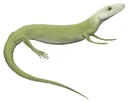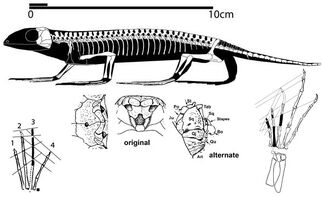
Protorothyris archeri.
Protorothyrididae is a family of small, lizard-like reptiles. Their skulls did not have fenestrae, as is also true of modern turtles and tortoises. Protorothyridids lived from the Late Carboniferous to Early Permian periods, in what is now North America.[1][2][3][4]
Many genera of primitive reptiles were thought to be protorothyridids. Brouffia, Coelostegus, and Hylonomus, for example, were recently found to be more basal eureptiles.[5][6]
Genus and Species[]
Protorothyris[]
Protorothyris is an extinct genus of Early Permian protorothyridid known from Texas and West Virginia of the United States. It was first named by Llewellyn Ivor Price in 1937 and the type species is Protorothyris archeri. Protorothyris was the size of a lizard.[7][8][9]

Protorothyris morani.
- Protorothyris archeri is known from the holotype MCZ 1532, a three-dimensionally preserved skull. It was collected in the Cottonwood Creek site, from the Archer City Formation, Texas, dating to the Asselian stage of the Cisuralian epoch, about 299-294.6 million years ago.
- Protorothyris morani, a second species, was first named by Alfred Sherwood Romer in 1952 with its own generic name, Melanothyris. In 1973, J. Clark and Robert L. Carroll recombined P. morani as a Protorothyris species. It is known from the holotype CM 8617, a three-dimensionally preserved skull. It was collected in the Blacksville site, from the Washington Formation (Asselian stage) of West Virginia.
Cephalerpeton ventriarmatum[]

Cephalerpeton ventriarmatum skeleton.
Cephalerpeton ventriarmatum (meaning armored-belly reptilian head) is an extinct genus of Late Carboniferous (late Westphalian stage) protorothyridid known from Illinois. It is known from the holotype YPM 796, a partial skeleton. It was collected in the Mazon Creek site, from the Francis Creek Shale Member of the Carbondale Formation. It was first named by R. L. Moodie in 1912 as a amphibamid amphibian. It was first assigned to Protorothyrididae by Robert L. Carroll and Donald Baird in 1972 and this placement has been widely accepted.[10]
Anthracodromeus longipes[]

Anthracodromeus longipes skeleton.
Anthracodromeus longipes (meaning "long-legged coal runner") is an extinct genus of Late Carboniferous (late Westphalian stage) protorothyridid known from Ohio. It is known from the holotype AMNH 6940, a nearly complete skeleton. It was collected in the Linton site in Jefferson County, from the upper Freeport Coal Member. A. longipes was first assigned by Edward Drinker Cope in 1875 to a species of Sauropleura. The genus was first named by Robert L. Carroll and Donald Baird in 1972.[11]
References[]
- ↑ www.fossilworks.org/cgi-bin/bridge.pl?a=taxonInfo&taxon_no=37486
- ↑ palaeos.com/vertebrates/eureptilia/protorothyrididae.html
- ↑ https://rolandworldofreptiles.tripod.com/Protorothyrididae.html
- ↑ https://search.worldcat.org/title/6907862
- ↑ https://eweb.furman.edu/~wworthen/bio440/evolweb/carboniferous/proto.htm
- ↑ https://www.scientificlib.com/en/Biology/Animalia/Chordata/Reptilia/Protorothyrididae.html
- ↑ https://eol.org/pages/4532152
- ↑ taxonomicon.taxonomy.nl/TaxonTree.aspx?src=4121&id=48115
- ↑ https://paleobiodb.org/classic/checkTaxonInfo?taxon_no=37493&is_real_user=1
- ↑ https://www.reptileevolution.com/protorothyris.htm
- ↑ https://www.reptileevolution.com/protorothyris.htm